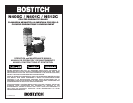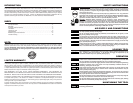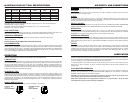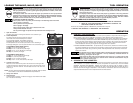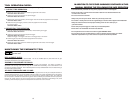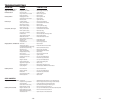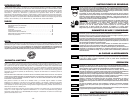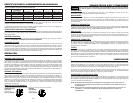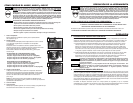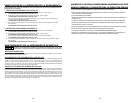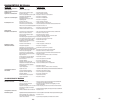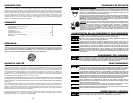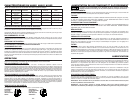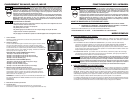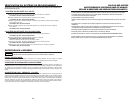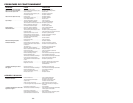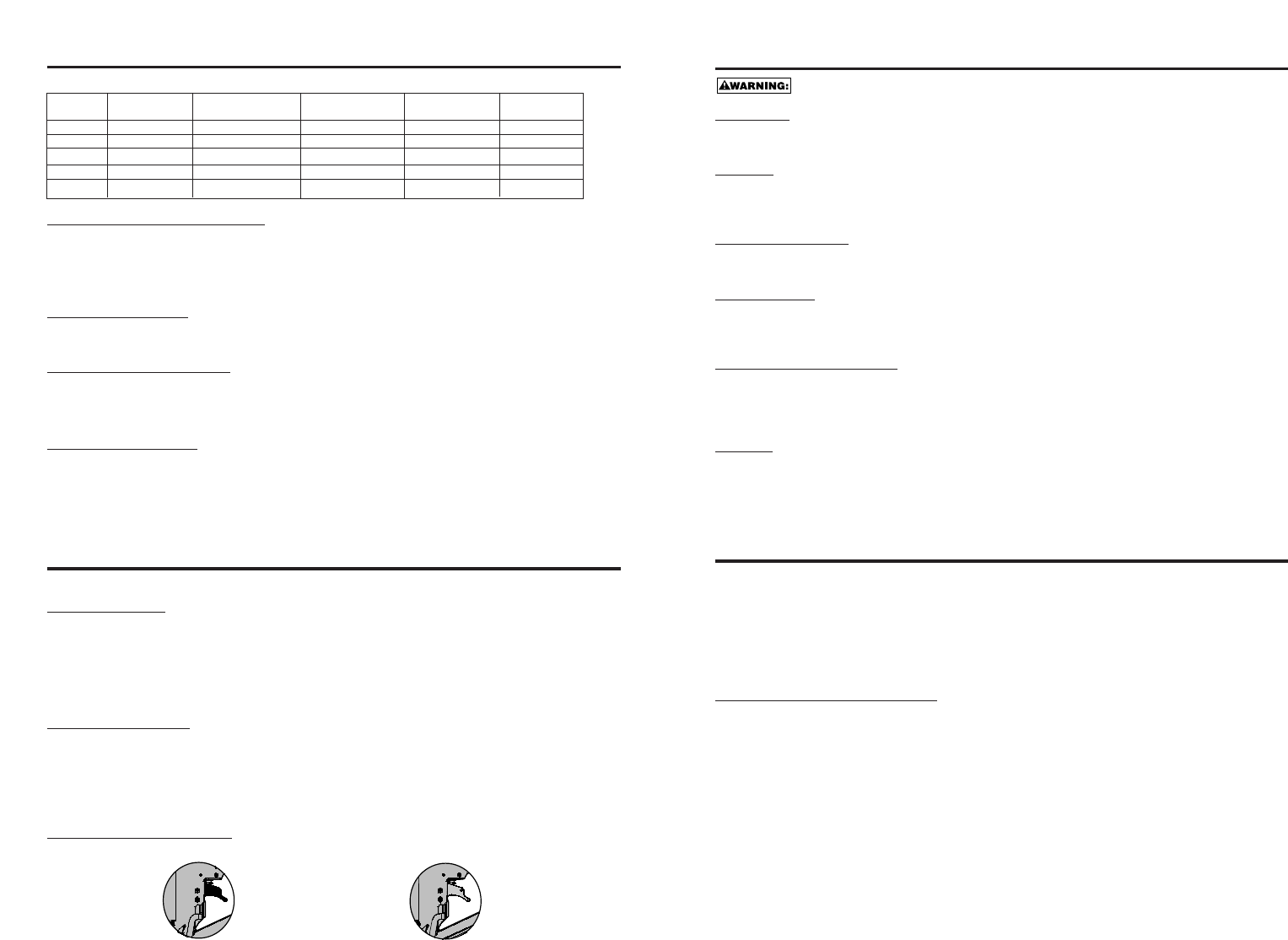
AIR SUPPLY AND CONNECTIONS
Do not use oxygen, combustible gases, or bottled gases as a power source for this tool as
tool may explode, possibly causing injury.
FITTINGS:
Install a male plug on the tool which is free flowing and which will release air pressure from the tool when
disconnected from the supply source.
HOSES:
Air hoses should have a minimum of 150 p.s.i. (10.6 kg/cm
2
) working pressure rating or 150 percent of the
maximum pressure that could be produced in the air system. The supply hose should contain a fitting that will
provide “quick disconnecting” from the male plug on the tool.
SUPPLY SOURCE:
Use only clean regulated compressed air as a power source for this tool. NEVER USE OXYGEN, COMBUSTIBLE
GASES, OR BOTTLED GASES, AS A POWER SOURCE FOR THIS TOOL AS TOOL MAY EXPLODE.
REGULATOR:
A pressure regulator with an operating pressure of 0 - 125 p.s.i. (0 - 8.79 kg/cm
2
) is required to control the
operatiing pressure for safe operation of this tool. Do not connect this tool to air pressure which can potentially
exceed 200 p.s.i. (14 kg/cm
2
) as tool may fracture or burst, possibly causing injury.
OPERATING PRESSURE:
Do not exceed recommended maximum operating pressure as tool wear will be greatly increased. The air
supply must be capable of maintaining the operating pressure at the tool. Pressure drops in the air supply can
reduce the tool’s driving power. Refer to “TOOL SPECIFICATIONS” for setting the correct operating pressure
for the tool.
FILTER:
Dirt and water in the air supply are major causes of wear in pneumatic tools. A filter will help to get the best
performance and minimum wear from the tool. The filter must have adequate flow capacity for the specific
installation. The filter has to be kept clean to be effective in providing clean compressed air to the tool. Consult
the manufacturer’s instructions on proper maintenance of your filter. A dirty and clogged filter will cause a
pressure drop which will reduce the tool’s performance.
LUBRICATION
Frequent, but not excessive, lubrication is required for best performance. Oil added through the air line
connection will lubricate the internal parts. Use BOSTITCH Air Tool Lubricant, Mobil Velocite #10, or equivalent.
Do not use detergent oil or additives as these lubricants will cause accelerated wear to the seals and bumpers
in the tool, resulting in poor tool performance and frequent tool maintenance.
If no airline lubricator is used, add oil during use into the air fitting on the tool once or twice a day. Only a few
drops of oil at a time is necessary. Too much oil will only collect inside the tool and will be noticeable in the
exhaust cycle.
COLD WEATHER OPERATION:
For cold weather operation, near and below freezing, the moisture in the air line may freeze and prevent tool
operation. We recommend the use of BOSTITCH WINTER FORMULA air tool lubricant or permanent
antifreeze (ethylene glycol) as a cold weather lubricant.
CAUTION: Do not store tools in a cold weather environment to prevent frost or ice formation on the
tools operating valves and mechanisms that could cause tool failure.
NOTE: Some commercial air line drying liquids are harmful to “O”-rings and seals – do not use these
low temperature air dryers without checking compatibility.
-5--4-
N400C/N401C/N512C TOOL SPECIFICATIONS
All screws and nuts are metric.
FASTENER SPECIFICATIONS:
The N400C, N401C, tool uses wire collated coil nails in lengths of 2-1/4” to 4” (55 - 100 mm) with shank
diameters of .099” –.148” (2.5 - 3.8mm).
The N512C, tool uses wire collated coil nails in lengths of 3” to 5” (75 - 130 mm) with shank
diameters of .120 -.148 (3.05 - 3.8mm).
TOOL AIR FITTING:
This tool uses a free-flow connector plug, 3/8” N.P.T. The minimum inside diameter should be .270” (5mm). The
fitting must be capable of discharging tool air pressure when disconnected from the air supply.
OPERATING PRESSURE:
70 to 120 p.s.i.g. (4.8 to 8.3 kg/cm
2
). Select the operating pressure within this range for best
fastener performance.
DO NOT EXCEED THE RECOMMENDED OPERATING PRESSURE.
AIR CONSUMPTION:
The N400C, N401C, requires 12.3 cubic feet per minute (.348 m
3
) of free air to operate at the rate of 100 nails per
minute, at 80 p.s.i. (5.6 kg/cm
2
). The N512C, requires 13.5 cubic feet per minute (.382 m
3
) of free air to operate at the
rate of 100 nails per minute, at 80 p.s.i. (5.6 kg/cm
2
). Take the actual rate at which the tool will be run to determine the
amount of air required. For instance, if your fastener usage averages 50 nails per minute, you need 50% of the tool’s
c.f.m. which is required to operate the tool at 100 nails per minute.
OPERATION
BOSTITCH OFFERS TWO TYPES OF OPERATION FOR THIS SERIES TOOL.
CONTACT TRIP:
The common operating procedure on “Contact Trip” tools is for the operator to contact the work to actuate the
trip mechanism while keeping the trigger pulled, thus driving a fastener each time the work is contacted. This
will allow rapid fastener placement on many jobs, such as sheathing, decking and pallet assembly. All
pneumatic tools are subject to recoil when driving fasteners. The tool may bounce, releasing the trip, and if
unintentionally allowed to recontact the work surface with the trigger still actuated (finger still holding trigger
pulled) an unwanted second fastener will be driven.
SEQUENTIAL TRIP:
The Sequential Trip requires the operator to hold the tool against the work before pulling the trigger. This
makes accurate fastener placement easier, for instance on framing, toe nailing and crating applications.The
Sequential Trip allows exact fastener location without the possibility of driving a second fastener on recoil, as
described under “Contact Trip”. The Sequential Trip Tool has a positive safety advantage because it will not
accidentally drive a fastener if the tool is contacted against the work – or anything else – while the operator is
holding the trigger pulled.
MODEL IDENTIFICATION:
Refer to Operation Instructions on page 7 before proceeding to use this tool.
CONTACT TRIP SEQUENTIAL TRIP
Identified by: Identified by:
BLACK TRIGGER GRAY TRIGGER
MODEL
TOOL
LENGTH HEIGHT WIDTH WEIGHT
ACTUATION
N400C-1 Contact Trip 13.3” (338mm) 16.6” (423mm) 6” (153mm) 11.6 lb (5.3 kg)
N400C-2 Sequential Trip 13.3” (338mm) 16.6” (423mm) 6” (153mm) 11.6 lb (5.3 kg)
N401C-1 Contact Trip 13.3” (338mm) 16.6” (423mm) 6” (153mm) 11.6 lb (5.3 kg)
N401C-2 Sequential Trip 13.3” (338mm) 16.6” (423mm) 6” (153mm) 11.6 lb (5.3 kg)
N512C-2 Sequential Trip 13.3” (338mm) 19.0” (484mm) 6” (153mm) 12.8 lb (5.8 kg)



